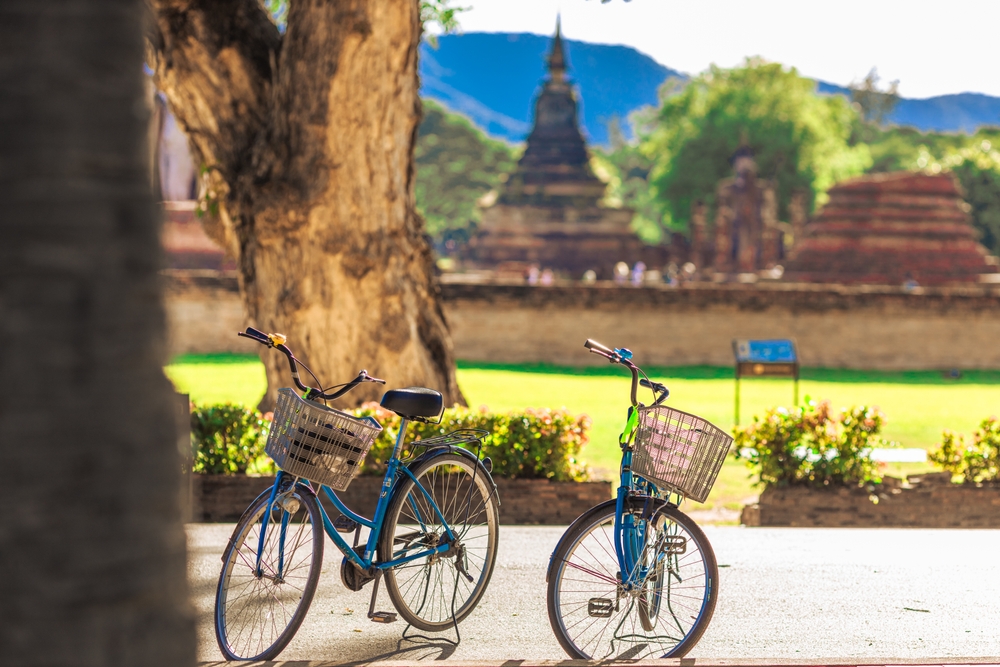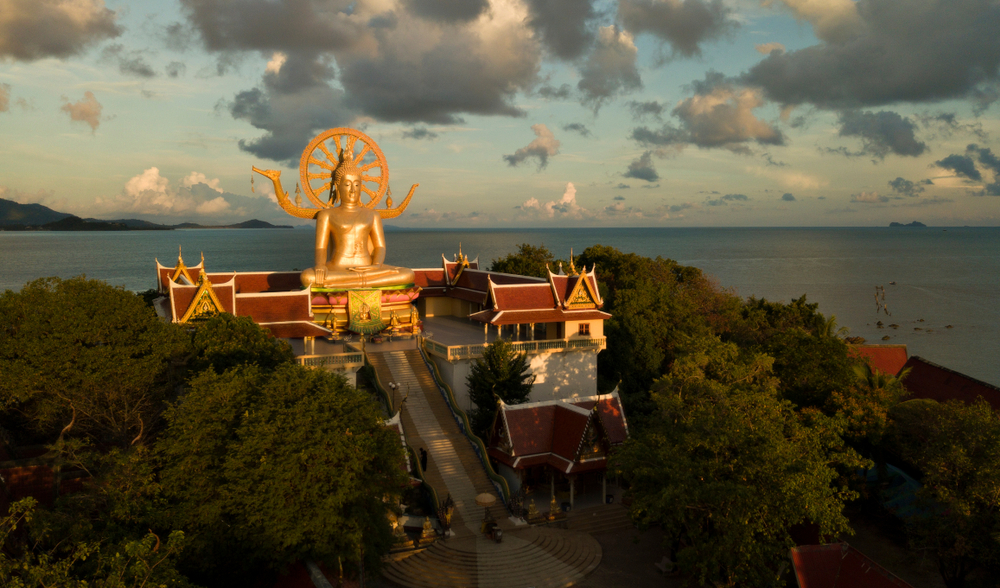Bangkok Airways Round-Up
- Explore Thailand’s first capital of Sukhothai, and discover the traditional arts and architecture. As a historical town, it is essential to learn about the history and culture through the World Heritage site, the ancient ruins of palaces and temples, and the local way of life.
- Sukhothai offers more than the historical site as it is home to an abundance of nature. There are plenty of activities to enjoy at the national parks, such as hiking, trekking, and camping. Moreover, you can wander through the temples and local neighbourhoods while trying some of the delicious dishes that you will fall in love with.
Sukhothai Style: The Soul of Thai Art and Architecture
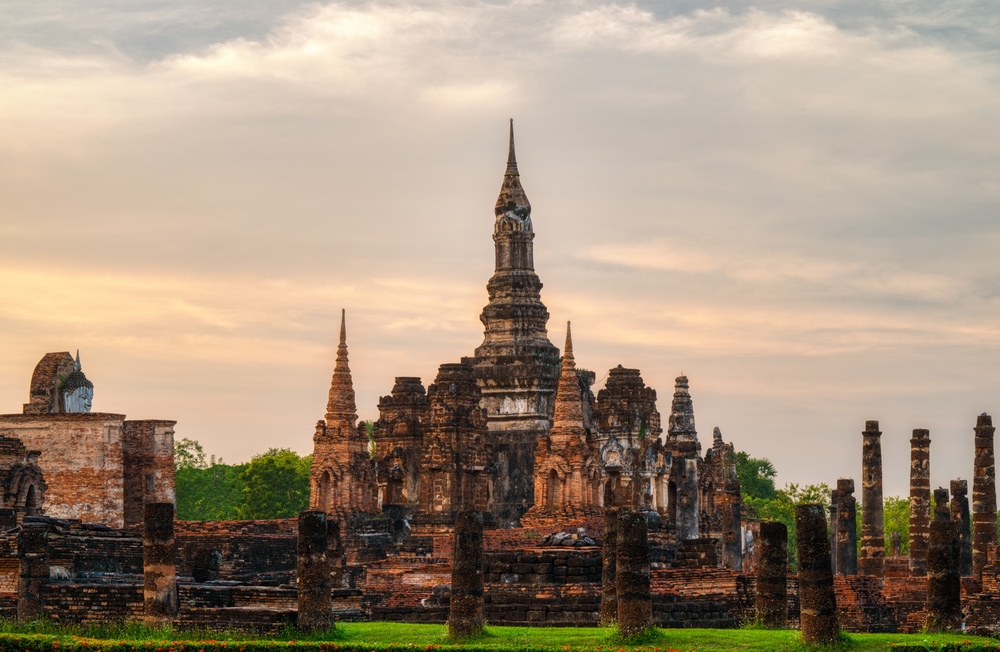
Sukhothai is a historic town with numerous temples and Buddhist monasteries, offering a rich culture through ancient structures. From the 13th to 15th centuries, Sukothai was the first capital of the Kingdom of Siam, the former official name of Thailand. During this period, many characteristics of Thai culture were invented and developed, especially in art and architecture.
With its distinctive style from Khmer and other regional styles, this unique art form was given its own name, ‘Sukhothai style’. This can be admired and observed at the remaining temples and monasteries, as many sculptures, wall paintings, and ancient decorations were found in various temples.
As a former capital of Thailand, Sukhothai is a perfect destination for those seeking a deeper connection to Thailand’s cultural heritage. Bangkok Airways has gathered the top 14 interesting things to do in Sukhothai in this comprehensive guide for you.
14 Things to Do and See in Sukhothai, Thailand
1. Discover Ancient Temples at Sukhothai Historical Park
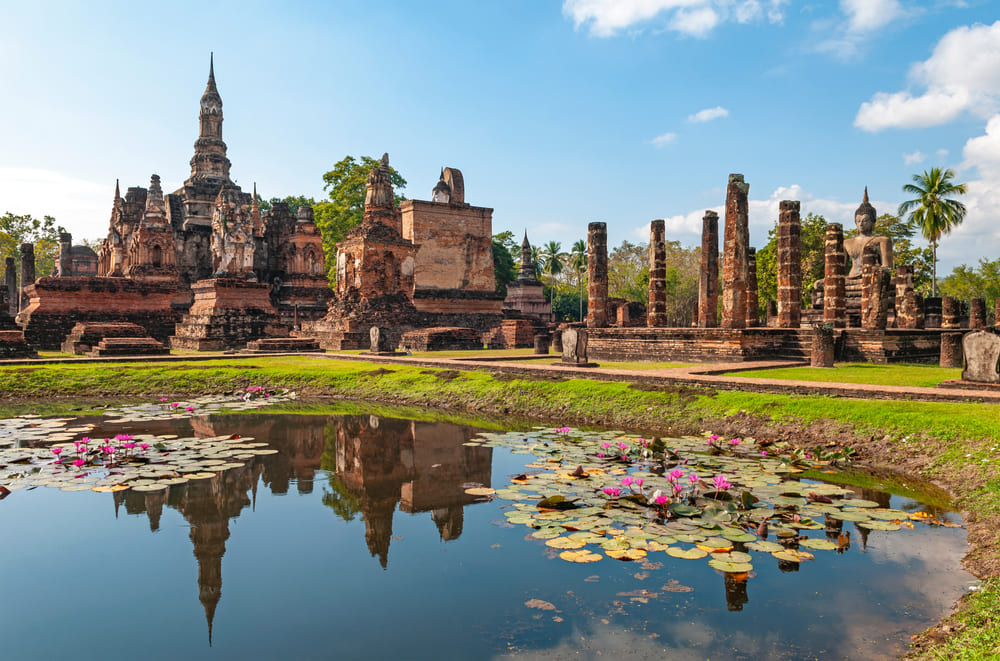
On December 12, 1991, UNESCO declared Sukhothai Historical Park as the 574th World Heritage. The park has become another highlight of the city, with 58 historical sites filled full of remains and ruins to discover.
This massive park is divided into five zones, including the central, north, south, east and west. Throughout the historical park, you will find most stupas in the shape of a lotus bud with a conical spire, but some of them have been modified into bell-shaped or double-tiered stupas.

At the northern part of Sukhothai Historical Park, Wat Si Chum is a remarkable temple that is a must-visit destination in this World Heritage site. Inside the temple, you will find a Sukhothai-style Buddha statue in the subduing Mara posture, known as Phra Phuttha Acana. This Buddha statue presents a captivating presence, attracting visitors and pilgrims with its sacred aura and reverence.
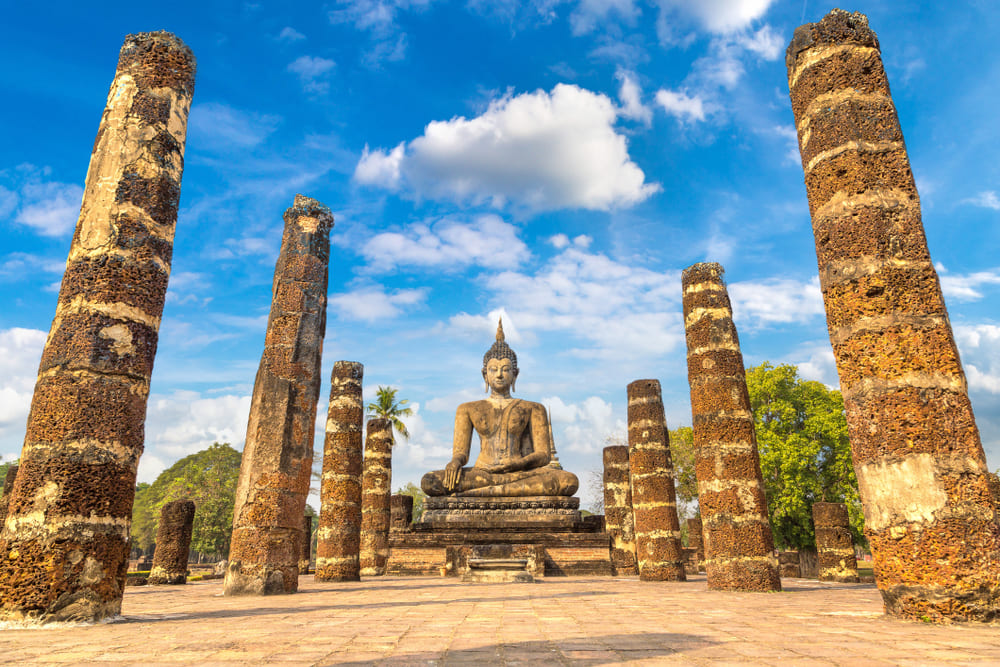
Situated in the eastern zone, Wat Mahathat is the largest and most important temple in the park. The main stupa of the temple complex is shaped like a lotus bud shape with a spire at the top, representing the mythical Mount Meru, where it enshrines relics of the Buddha.
Surrounding the main stupa, you will find many other smaller ones, totalling over 200 subordinate stupas. Many of them were added across different periods, representing the mountain ranges to portray infinity. Take a stroll and discover the ancient ruins that have been around for centuries, while taking photos for a memorable visit.
Opening hours: Daily, 6.30 am. – 7.30 pm.
Entrance fee:
- Thai: 20 baht
- Foreigner: 100 baht
2. Embrace the Nature At Ramkhamhaeng National Park

Located about 24 kilometers from the Sukhothai Historical Park, Ramkhamhaeng National Park covers about 341 square kilometers of countryside, hilltop mountains, cascading waterfalls, and green forests. The park acquired its name after the great King Ramkhamhaeng of the Sukhothai Kingdom. With its rich natural resources, the park attracts both locals and tourists to explore its wilderness.
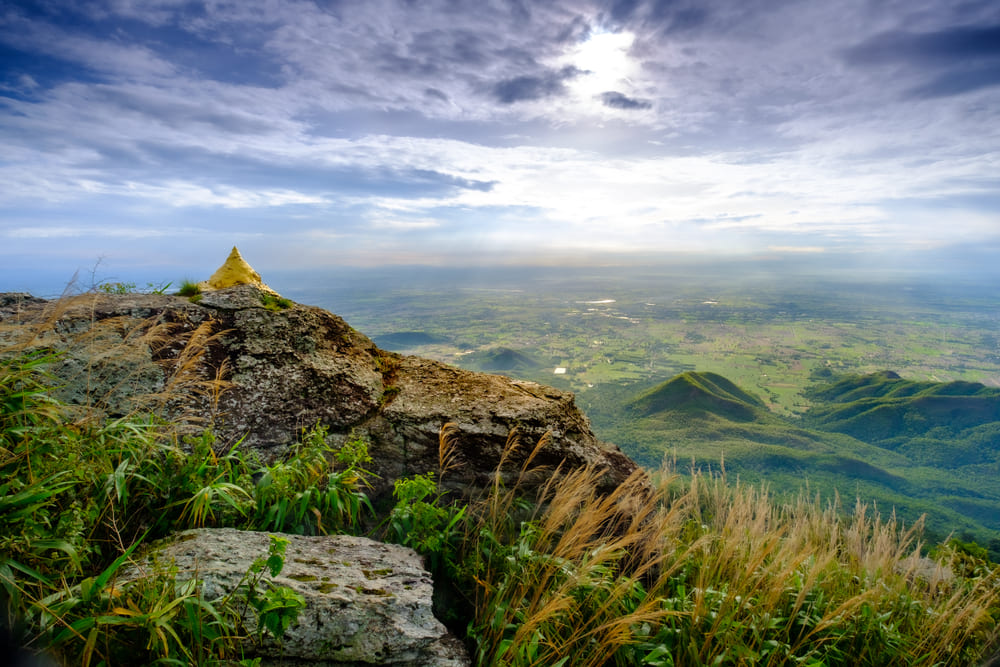
One of the main attractions at the park is the Khao Luang mountain range, perfect for travelers to take in the views of towering hills and steep cliffs from 1,200 meters above sea level, while exploring historical sites and discovering ancient relics. It is also a popular trekking and hiking trail for adventure lovers.
With its abundant nature, Khao Luang is excellent for backpacking, birdwatching, and camping. Accommodation is available with a selection of bungalows and tents hosted by the National Park Section and the Royal Forest Department.
Notes:
- The trail at Khao Luang is open year-round, but visitors are advised to be extra careful during the rainy season from July to September.
- Visitors must start trekking before 3.30 a.m. and bring their own food and personal belongings.
In addition to the natural abundance, Ramkhamhaeng National Park also has some links to the region’s spiritual heritage. It is home to the intriguing Buddha’s footprint carved in stone and adorned with sacred symbols, marking an important site for Thai pilgrims. Whether it be immersing in nature or culture, the park offers an amazing blend of both experiences in one place.
Opening hours: Daily, 8.30 am. – 4.30 pm.
Admission fee:
- Thai: Adult 20 baht, child 10 baht
- Foreigner: Adult 200 baht, child 100 baht

3. Live Like a Local at Ban Na Ton Chan
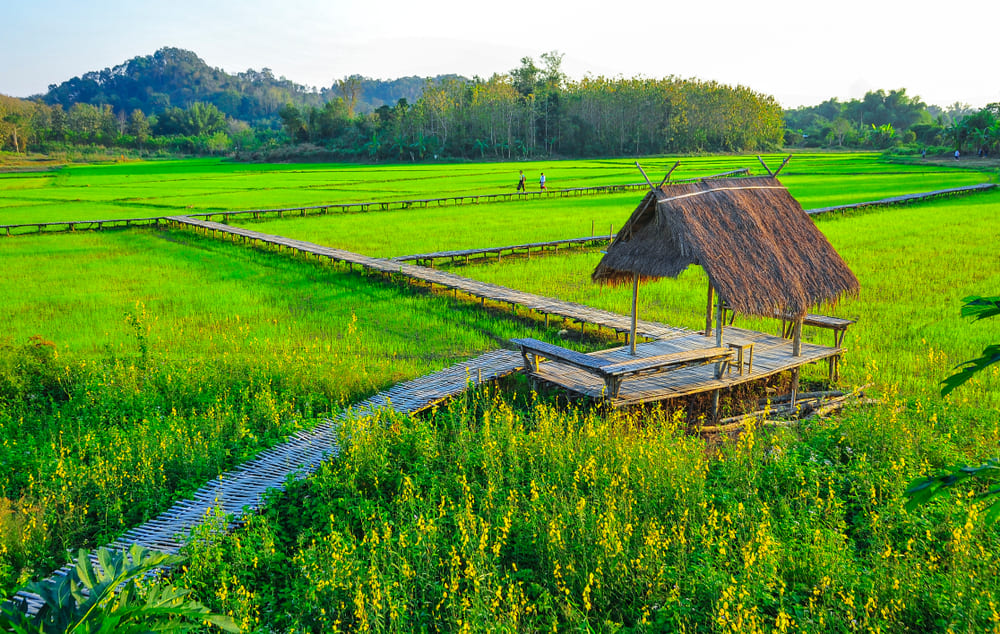
Experience the local life by exploring and staying at Ban Na Ton Chan. As an ecotourism village, there are a number of homestays in the community offering the traditional lifestyle of the villagers of Lanna. The village will bring you back to a basic lifestyle, and enjoy the simplicity of life.
Many activities at Ban Na Ton Chan are eco-friendly and focus on environmental sustainability. Some of the interesting things to do are observing the way of life by taking an E-Tak (local vehicle), admiring the sunrise at Huai Ton Hai viewpoint, and cycling to the green fields.
While you are at the village, there are many opportunities to explore the traditional way of mixed farming, such as cooking local food and making handicrafts from mud and bamboo. The final must-do activity is visiting the bamboo bridge of Ban Na Ton Chan. This scenic bamboo bridge has become an iconic spot for visitors, offering panoramic views of rice fields.
4. Visit the Ancient Sites of Si Satchanalai Historical Park
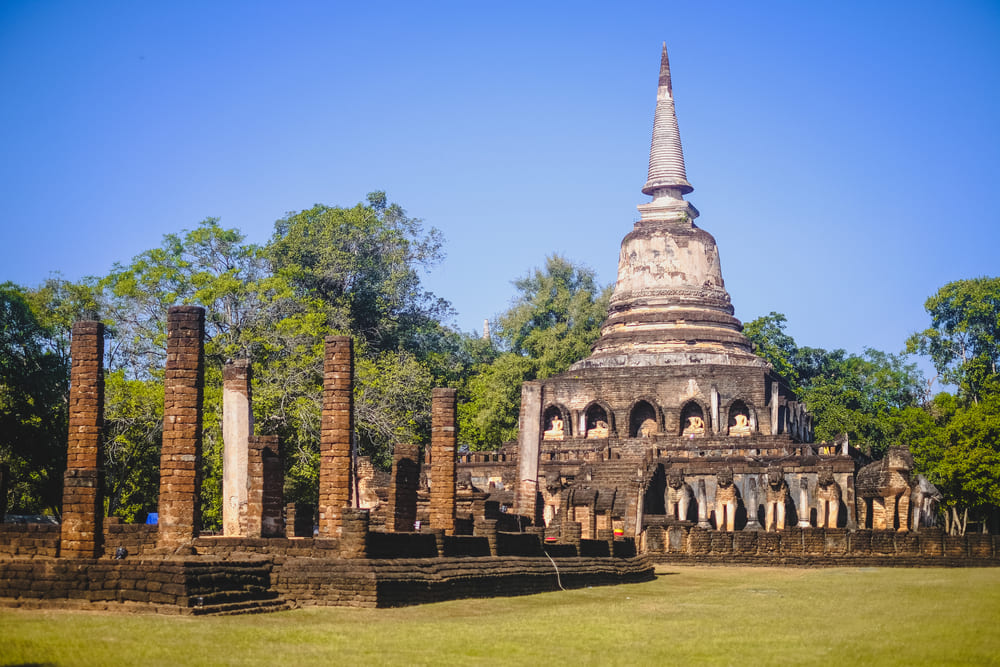
Located on the banks of the Yom River, Si Satchanalai Historical Park is a 45-square-kilometer historical site containing the remnants of ancient palaces, temples, and homes. The park’s attractions feature authentic Sukhothai architectural style, with Wat Chang Lom as one of the main attractions.
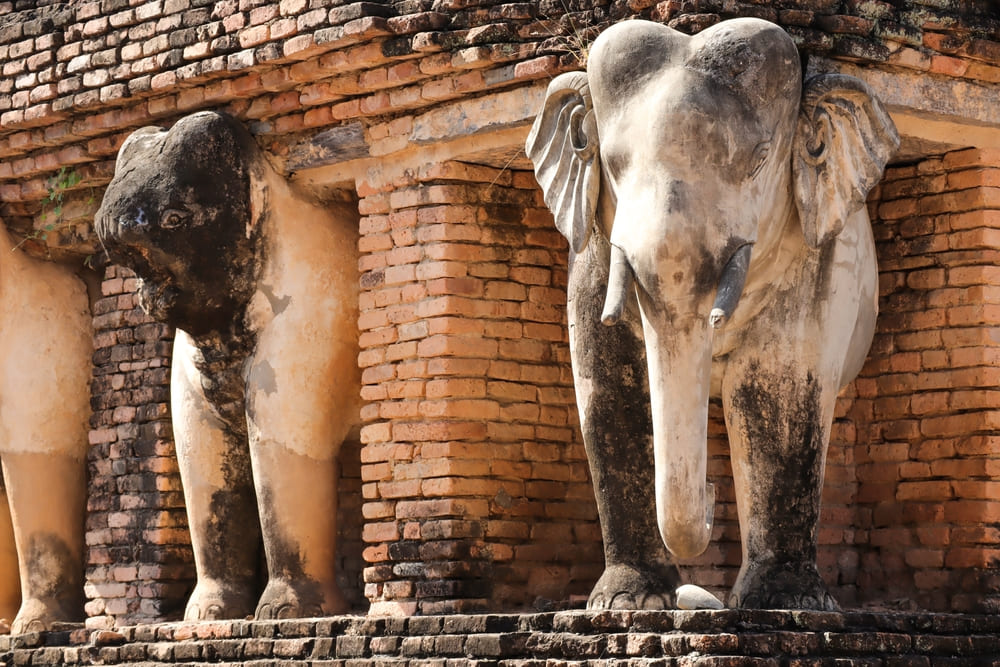
Built in the 15th century, Wat Chang Lom is situated in the center of the historic town with the bell-shaped main stupa and life-sized elephant sculptures encircling the base. These elephant sculptures seem to carry the weight of the stupa, symbolizing strength and representing the revered elephant who supported the Buddha and bore his relics. As Wat Chang Lom offers a peaceful yet majestic experience, visitors are free to explore and take photos of the photogenic ruins in the area.
Opening hours: Daily, 8.30 am. – 4.30 pm.
Entrance fee:
- Thai: 20 baht
- Foreigner 100 baht
5. Admire Historical Features at Wat Phra Sri Rattana Mahathat Rajaworaviharn
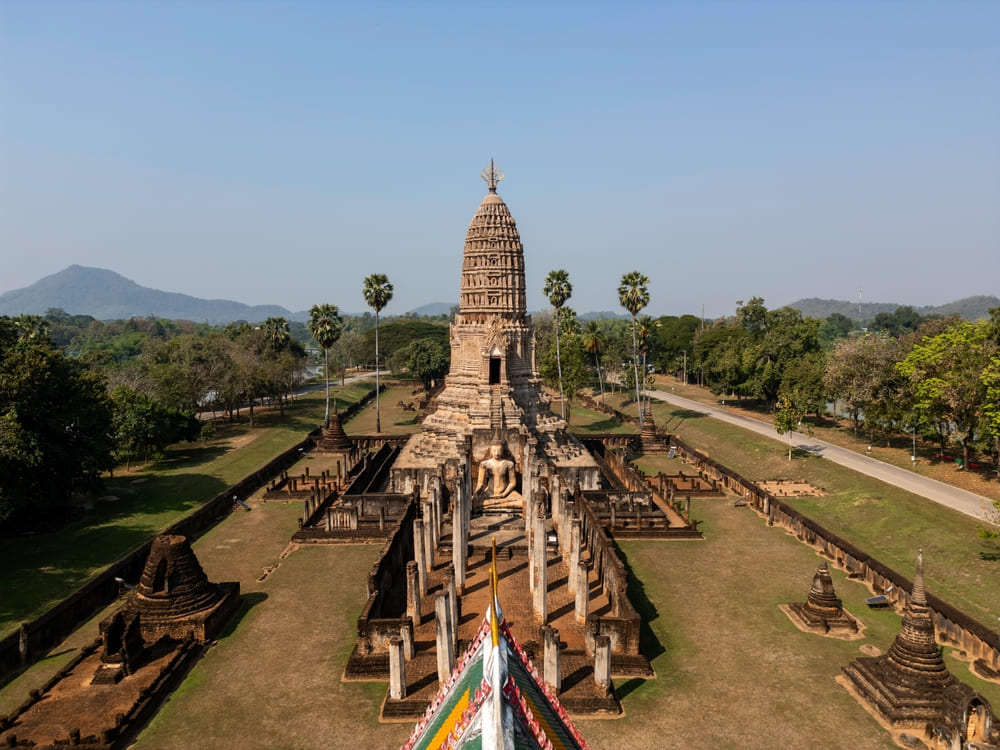
About 2.5 kilometers from the Si Satchanalai Historical Park, Wat Phra Sri Rattana Mahathat Rajaworaviharn is situated in the heart of the city. This ancient temple is home to a large Buddha image in the subduing Mara posture and another one in the walking posture.
Admire the temple walls made of large stone slabs, which form a rectangular enclosure measuring 60 meters wide and 90 meters long. As you walk to the entrance, look up at the entrance arch, and you will find a remarkable feature of a sculpted face of Avalokiteshvara Bodhisattva.
If you are someone who appreciates ancient art and historical architecture, Wat Phra Sri Rattana Mahathat Rajaworaviharn is a must-visit destination in Sukhothai that portrays the beauty of Thailand’s ancient heritage.
6. Observe Artefacts At Sawanvoranayok National Museum

Established in 1984, Sawanvoranayok National Museum showcases a variety of sculptural art throughout long historical periods. The museum preserves artefacts from the ancient times of Sukhothai and Si Satchanalai.
When you visit the museum, don’t miss the opportunity to explore the extensive collection of Sangkhalok ceramics. These are rare ceramic items that were recovered from shipwrecks in the Gulf of Thailand. With its ancient history dating back to the Sukhothai era, these one-of-a-kind artefacts are extremely rare and now on display for visitors to admire the region’s craftsmanship.
Opening hours: Wednesday – Sunday, 9.00 am. – 4.00 pm.
Entrance fees:
- Thai: 10 baht
- Foreigner: 30 baht
7. Experience the Sight of The Holy Heartland – Talayluang
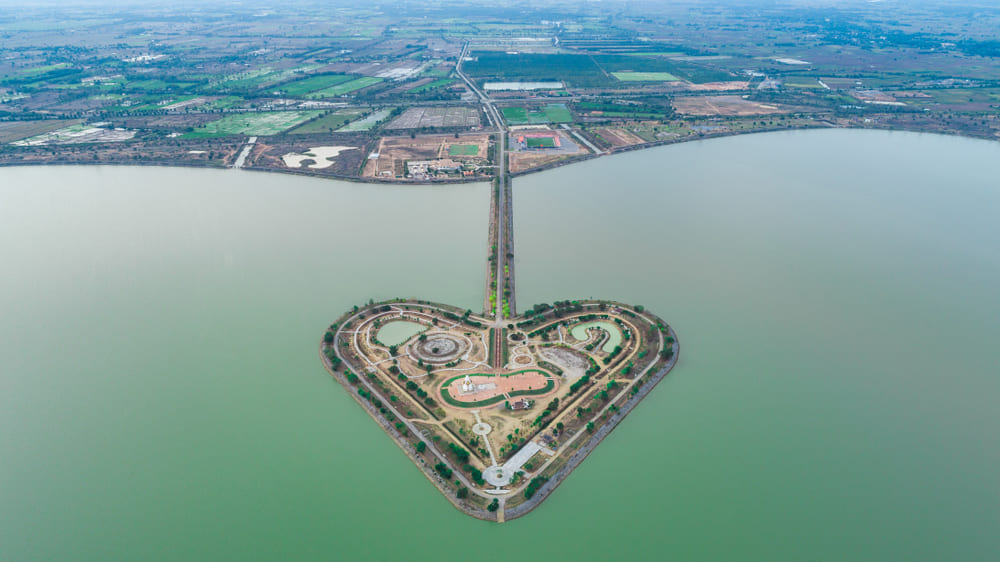
Travelers flying to Sukhothai may catch a glimpse of a heart-shaped reservoir from above. Known as the Holy Heartland, this unique and enormous reservoir is located just about 15 kilometers from Sukhothai Historical Park.
The Holy Heartland was completed in 2002 from the concept of “Kaem Ling”, also known as the Monkey Cheek water management project, to address flooding and drought problems in the area. This reservoir serves as a water restoration during the dry season, designed in the shape of a heart to symbolize love and unity of the people of Sukhothai.
On the island, a central pavilion was built to enshrine Phra Phuttha Ratanasiri Sukhothai. The statue is believed to be from the 14th century. Due to its tranquillity and vast area, it has become a popular spot to watch the sunrise and sunset, where the atmosphere is most serene.
Opening hours: Daily, 8.00 am. – 6.00 pm.
Entrance fee: Free
8. Chill Out At Chao Ram Reservoir

If you are looking for beautiful natural scenery in Sukhothai, Chao Ram Reservoir should be at the top of your list. Located within the area of Huai Nong Kho Reservoir, this is a must-visit destination for nature lovers.
Surrounded by mountains, Chao Ram Reservoir offers the ultimate relaxation atmosphere, perfect for visitors of all ages. Around the area, there are many food stalls available, as well as swimming tubes for rent if you want a refreshing water activity. Enjoy the day and admire nature as you are surrounded by the beautiful mountain range at the reservoir.
Opening hours: Daily, 9.00 am. – 7.00 pm.
9. Connect Spiritually At Wat Phiphat Mongkhon
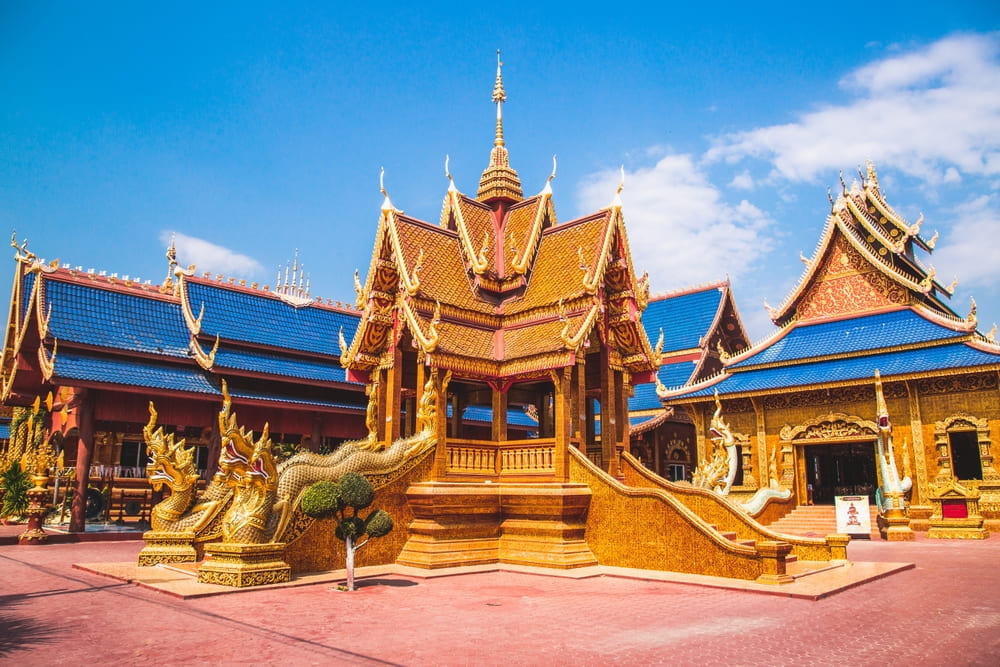
Wat Phiphat Mongkon is considered one of the most important temples in Sukhothai.
Inside the temple complex, there are many structures of a traditional ordination hall, the main Viharn, a meditation garden, a school, and a community kitchen.
In the center of the temple, you will find a golden Sukhothai-style Buddha image in the subduing Mara posture named Phra Phutthasukhophothong. This revered statue is made from 9 kilograms of gold, symbolizing the artistic craftsmanship and spiritual reverence.
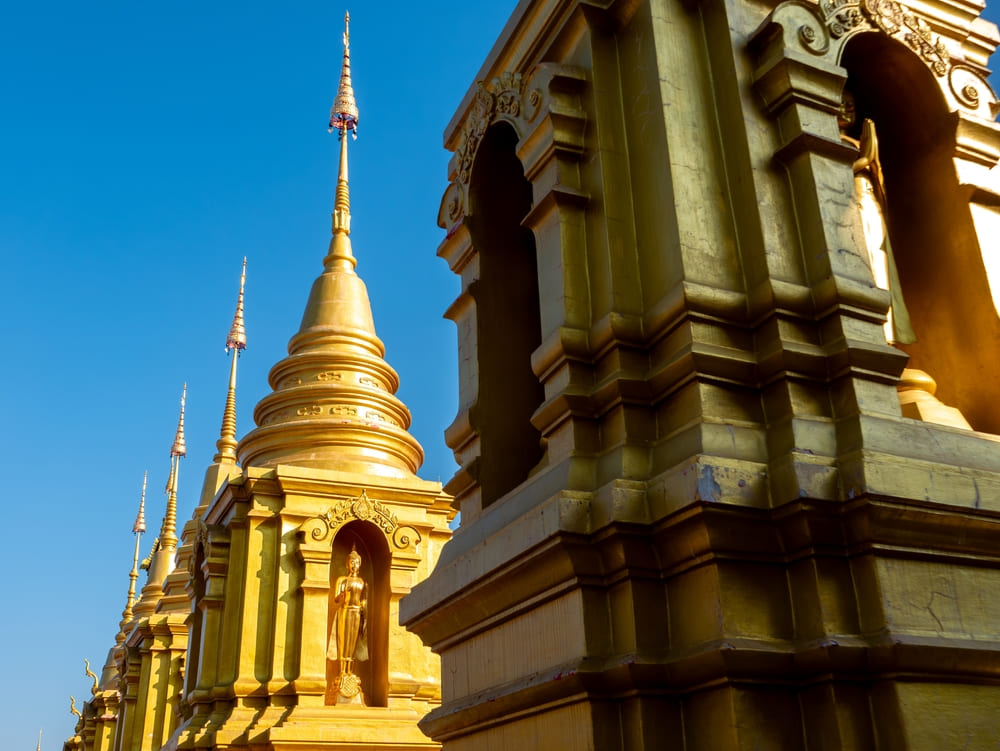
During the construction of the temple, some Sukhothai-era Buddha images were discovered and unearthed. These relics were safely preserved within the temple along with a set of Buddha relics from Sri Lanka, emphasizing the temple’s respected status of devotion.
Opening hours: Daily, 8.00 am. – 5.00 pm.
10. Immerse Breathtaking Nature At Doi Khao Mung
Doi Khao Mung is a must-visit attraction for nature enthusiasts. You will admire a breathtaking sea of misty fog from the top as if you are up in the clouds. Reaching Doi Khao Mung viewpoint is part of the adventure. As personal vehicles are not allowed, the journey to the viewpoint requires riding a local “E-Tak” tractor. Taking this big tractor might be a different experience, but it promises fun and excitement along the way.
Once you arrive at the summit, you will see the stunning panoramic view of a white sea of mist in the morning air. There is no better way to start the day than witnessing the sunrise creeping through the net of clouds– a memorable moment of peace where you rest your body and calm your mind.
11. Admire the Immense Saritphong Dam
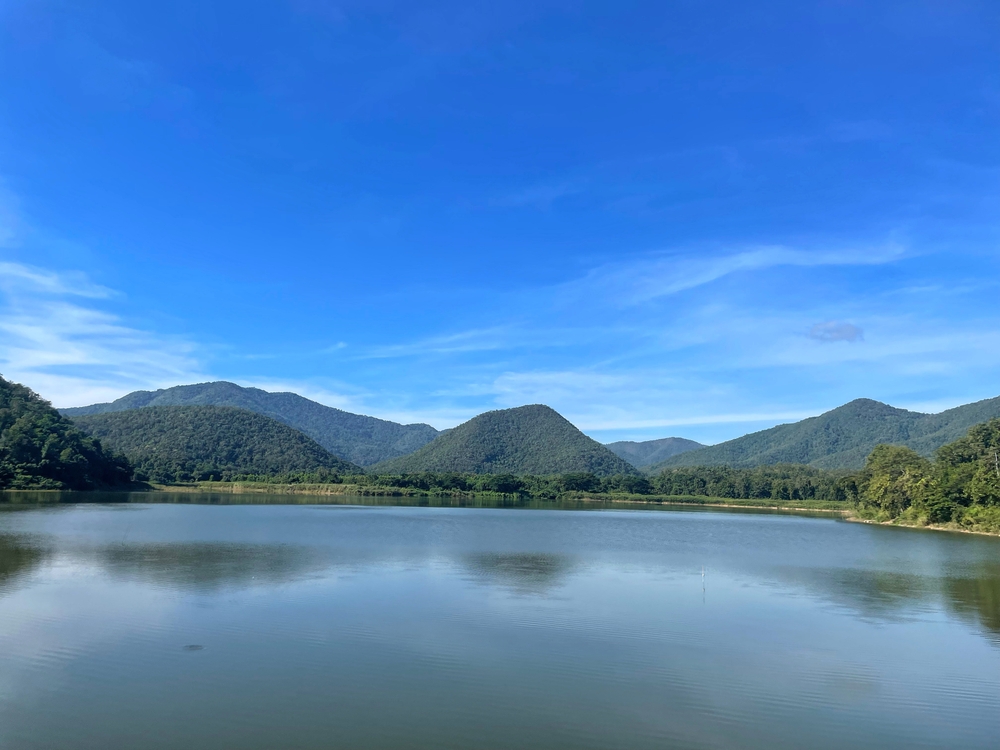
Saritphong Dam is located in the southwest of Sukhothai, helping capture and retain rainwater for the city. The dam was constructed to divert water from 17 natural sources. The water will then be channeled through Khlong Sao Ho into the city for use.
Surrounding the dam, the atmosphere offers calm, breathtaking scenery that brings relaxation. With expansive waters, rice fields, and green mountains, embrace the landscape and let yourself unwind while admiring the natural charm. The true highlight is the sunset at Saritphong Dam. As the sun slowly disappears behind the hills, the scenery becomes romantic and serene, perfect for relaxing, taking stunning photos, or enjoying a leisurely bike ride.

12. Pay Respect to the Phra Mae Ya Shrine
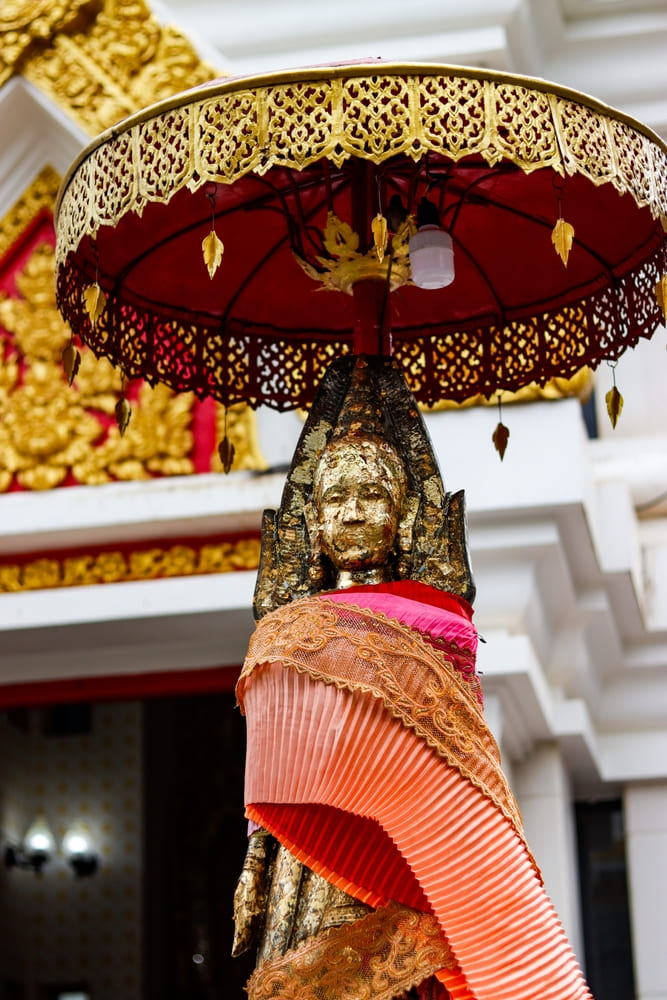
The Phra Mae Ya Shrine was built to honor the legacy of Phra Mae Ya, a young noblewoman from the Sukhothai period. While her identity remains uncertain, Thai historian, Ajarn Thongjure Suebchompoo, suggests she might be the mother of King Ramkhamhaeng. For this reason, the locals pay respect to her statue.
The astonishing statue of Phra Mae Ya is carved from a single block of rock. It is 52 inches tall, standing upright with a flowing traditional garment. As of today, Phra Mae Ya represents maternal strength and historical reverence in Sukhothai. Revered by the locals, many pilgrims and worshippers come to the shrine to make a wish and seek blessings. Boost your luck by making prayers and offering flowers to show respect to the Phra Mae Ya shrine.
Opening hours: Daily, 8.00 am. – 5.00 pm.
13. Visit the Local Cafe at Baan Ma-Kwid Sukhothai
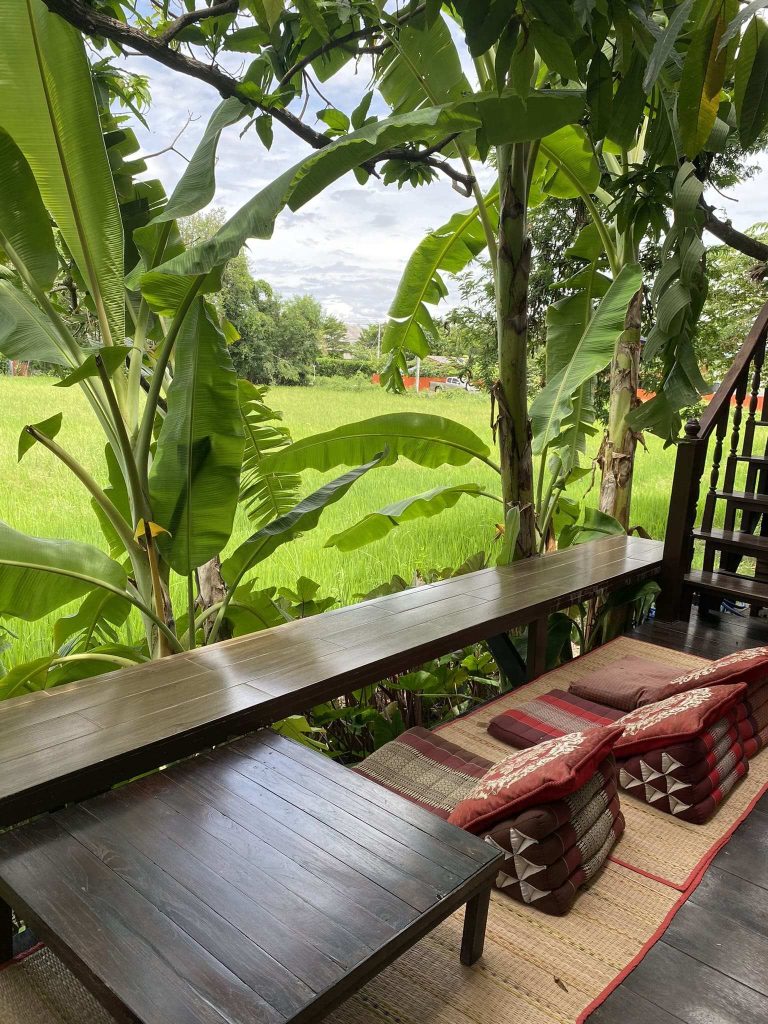
Baan Ma-Kwid is a local guesthouse and small cafe nestled beside rice fields in Sukhothai. Because of its location, the atmosphere is serene and welcoming for all visitors. In the mornings, it serves as a breakfast area for guests and turns into a cafe in the afternoons for customers.
This is not only a cafe but also a learning center teaching people how to make a traditional shoulder bag. The owner of Baan Ma-Kwid has a passion for making cloth bags. He decided to create a learning space for people to make bags that reflect their own identity and lifestyle. He has worked with the local community to help create jobs for those who love crafts.
14. Savour the Local Dish at Khao Perp Yai Krieng
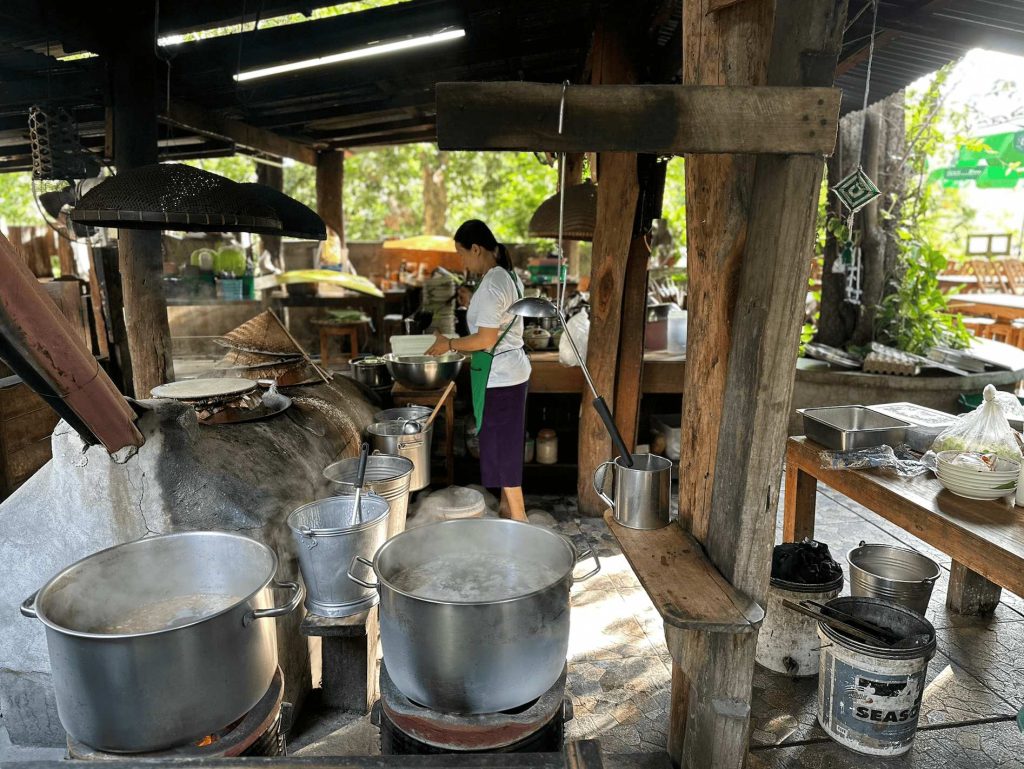
When in Sukhothai, Khao Perp is the local dish that you must try. This dish keeps popping up in guidebooks and travel reviews– even the locals would recommend it. To truly experience Sukhothai, you have to try Khao Perp at least once.
The origin of Khao Perp is “Khao Perp Yai Krieng”, located opposite Wat Na Ton Chan. The dish offers a blend of several things such as noodle soup, rice vermicelli, and steamed rice crepes. It begins with spreading a thin layer of fermented flour batter over a fine white cloth stretched across a steaming pot. As the flour sheet cooks, it is served in broth with noodle toppings. Because of its complexity and creativity, this might be one of the most unique Thai dishes.
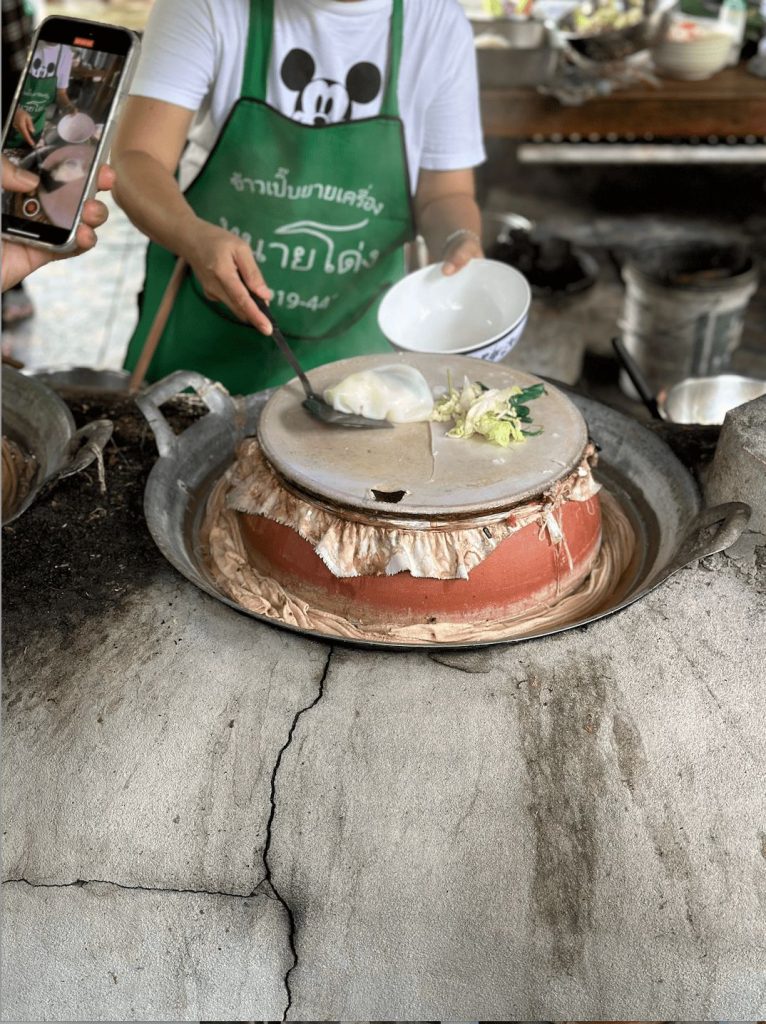
Not only is the dish hearty and delicious, but Khao Perp also serves as a cultural crossroads between the central and northern regions of Thailand. With the mix of local cuisine, it is a dish that represents cultural diversity and unity.
Opening hours: Daily, 8.00 a.m. – 5.00 p.m.
Best Time to Visit Sukhothai, Thailand

The ideal time to visit Sukhothai is when the weather is cooler, offering a nice breeze while you explore the historic city. The best time to visit is from December to February, as it is the cool and dry season in Thailand.
- November – February: The weather is at its coolest and driest, making it ideal for travelers to explore without worrying about the rain or heat. Walking outdoors and sightseeing are more comfortable.
- March – May: This is the summer season with high temperatures throughout Thailand. Travelers are advised to stay hydrated and apply sunscreen as the heat can be intense during the day.
- June – October: Rainstorms are expected during this period, which might be inconvenient for exploring the historic sites. However, it is a great time to visit for those who love hiking and exploring a lush, green landscape. The weather can be unpredictable, and travelers are advised to bring a raincoat or umbrella when going outside.
Explore More Destinations in Sukhothai, Thailand
- Tranquility Amidst Rain: Experience the Magic of Sukhothai in the Lush Season
- List Of Ancient Ruins In And Around Sukhothai Historical Park You Need To Explore
Discover the Ancient Town of Sukhothai with Bangkok Airways

Get ready to explore the rich culture and history of Sukhothai. Whether you are a nature lover or a curious historian of Thailand, Sukhothai will leave a lasting impression with its scenic landscapes, historical heritage, and diverse mix of cultures all in one place. Uncover the true beauty of this ancient town and travel in convenience with direct flights to the city. Start your journey with ease and let Bangkok Airways take you to your dream destination.
Bangkok Airways: Experience Unparalleled Comfort and Convenience.
Embark on seamless travel adventures with Bangkok Airways’ extensive network of flights connecting you to Singapore, Laos, Cambodia, and Hong Kong. Additionally, enjoy our domestic flights to Chiang Mai, Bangkok, Koh Samui, Sukhothai, and Trat.
- Seat Selection: Choose your preferred seat on your flight to ensure a comfortable journey.
- Baggage Allowance Included: Enjoy up to 20 kg of checked baggage, allowing you to bring along your essentials without worry.
- In-flight Meals: Savor delicious and satisfying meals on board, tailored to your taste preferences.
- Airport Lounge Access: Relax and unwind in our exclusive airport lounges before your flight.
“ Bangkok Airways, Asia’s Boutique Airline ”


